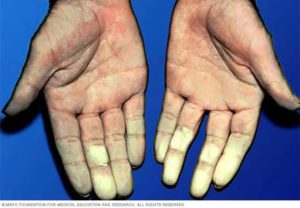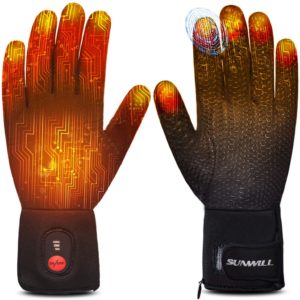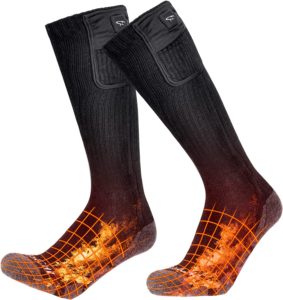During cold weather, have your hands ever hurt to the extent you cannot even use them? Have they turned pale or even white then blue when exposed to the cold, or during stress? Have they become swollen and painful when warmed? You may have Raynaud’s disease.
This disease occurs in 5-10% of the population and is caused by decreased blood flow to fingers (and occasionally ears, nose, knees and toes). There is a primary and secondary form. The primary form (which is the more common form) is when it occurs on its own, most people who have it have primary form and usually don’t need treatment.
The secondary form is caused by an underlying problem, and usually appears around age 40. Also called Raynaud’s phenomenon, this form is caused by an underlying problem. Although secondary Raynaud’s is less common than the primary form, it tends to be more serious.



Causes of Secondary Raynaud’s:
- Connective tissue diseases. Most people who have a rare disease that leads to hardening and scarring of the skin (scleroderma) have Raynaud’s. Other diseases that increase the risk of Raynaud’s include lupus, rheumatoid arthritis and Sjogren’s syndrome.
- Diseases of the arteries. These include a buildup of plaques in blood vessels that feed the heart, a disorder in which the blood vessels of the hands and feet become inflamed, and a type of high blood pressure that affects the arteries of the lungs.
- Carpal tunnel syndrome. This condition involves pressure on a major nerve to your hand, producing numbness and pain in the hand that can make the hand more susceptible to cold temperatures.
- Repetitive action or vibration. Typing, playing piano or doing similar movements for long periods and operating vibrating tools, such as jackhammers, can lead to overuse injuries.
- Smoking. Smoking constricts blood vessels.
- Injuries to the hands or feet. Examples include a wrist fracture, surgery or frostbite.
- Certain medications. These include beta blockers for high blood pressure, migraine medications that contain ergotamine and sumatriptan, attention-deficit/hyperactivity disorder medications, certain chemotherapy agents, and drugs that cause blood vessels to narrow, such as some over-the-counter cold medications.
Certainly there are numerous causes, but today we will look at two common causes of Raynauds that can occur in the workplace: Carpal Tunnel Syndrome (CTS), or repetitive action or vibrations (separate from CTS).
Workers in a variety of fields can develop CTS. This usually occurs when there is repetitive hand motions or constant vibration or impact on the hand during work. Workers who use jackhammers, reciprocating saws, hammers, and other vibrating or constant impact equipment are at risk. Symptoms of CTS include
- Numbness or tingling in the hand and arm associated with pain
- Pins and needles sensation
- Hand clumsiness and a tendency to drop things
- Hand pain at night
- Pain with the use of hand
- Weakness in the hand and wrist
There are a variety of treatment options including surgery, NSAIDS, steroids, braces, physical therapy, and management.
You do not necessarily have to have diagnosed or even mild CTS to develop Raynaud’s. Just the use of vibrating or constant impact equipment can cause it.
Unfortunately, there is no cure for Raynaud’s phenomenon, but it can be managed with proper treatment. Treatment may include:
- Avoiding exposure to cold
- Keeping warm with gloves, socks, scarf, and a hat
- Stopping smoking
- Wearing finger guards over fingers with sores
- Avoiding trauma or vibrations to the hand (such as with vibrating tools)
- Taking blood pressure medicines during the winter months to help reduce constriction of the blood vessels
See this link for more information: Mayo Clinic Raynaud’s info
While continuing to work in cold weather is possible when you have Raynaud’s, it does require extra effort to avoid the cold. Management options include taking frequent short breaks in dry warm areas, working during the warmer part of the day, using warming drinks (not drinks with alcohol, which could worsen it), and wearing proper clothing. Keeping your hands and feet warm and dry BEFORE they get cold, that is the key. Additional management tools could be the use of heated gloves and socks, radiant heaters, and such equipment as heated water hoses, heated livestock tanks, anything to avoid those hands and feet getting wet!
Options could be:
 Tank Top Propane Heater – Product – Disability Work Consulting
Tank Top Propane Heater – Product – Disability Work Consulting
 Heated Gloves – Product – Disability Work Consulting
Heated Gloves – Product – Disability Work Consulting
 https://disabilityworkconsulting.com/product/heated-socks/
https://disabilityworkconsulting.com/product/heated-socks/
For more information about working in cold weather, here is a post link: https://disabilityworkconsulting.com/workinwinter/
